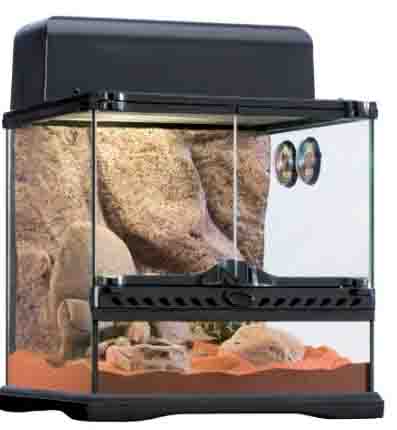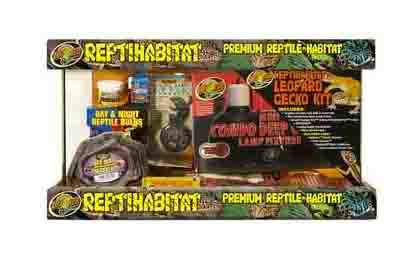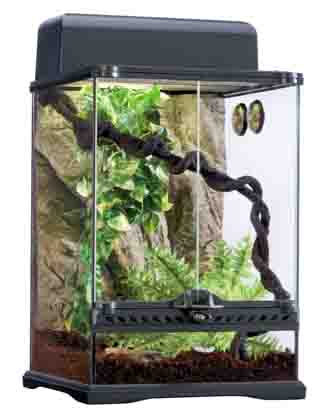How to Buy and Set Up a Gecko Cage or Terrarium
Setting up a Gecko Cage or Terrarium is part of the fun when owning a lizard. The basics are a glass or melamine interior tank (makes it easier to clean), wiht a tightly fitted door to prevent escape. Lizards requires that the vivarium have two temperatures, since they regulate body temperature with outside temperature. This means that during the day one end of the gecko cage will be at a higher temperature (usually 90F) with the lower end at 75F. The lizard will move from one area to the other depending on their needs.
To heat half the cage, an ultra-thin heat mat is the most efficient
method. They can be placed under or to the side of the terrarium.
Lighting is with an ordinary flourescent bulb. Other types of
lizards use a UVB lamp, but that is not necessary for gecko care. The
layout of the typical gecko cage includes a basking area for heat, and
a separate hiding area for privacy. The substrate that covers the cage
should be natural looking and can be something as simple as
paper. The cage is cleaned by removing the substrate.

This Desert Gecko Terrarium Kit Shows a Typical Setup for a Leopard
Gecko Cage
Source: Exo
Terra Desert Habitat Kit
Gecko Terrarium Kits
The easiest way to get started with a Gecko Terrarium
is to purchase a 10 gallon Gecko kit (40 liters). The kit comes with
everything
needed to get started and cost between $100 and $200. The easiest
way to think about a lizard care is to think about the Gecko's natural
environment. If your Gecko comes from the desert, then expect few
plants, and low humidity levels. Geckos from more tropical areas such
as Florida expect higher humidity and plants.
Geckos are ectotherms, which means their temperature is regulated by
the outside environment. To change body temperature in the wild they
move in and out of direct sunlight. Sunlight areas are referred
to as areas where the Gecko would bask. To create the same effect in
captivity. owners use a ceramic heat lamp over a basking area during
the day in one specific area of the gecko terrarium. The rest of the
habitat can be wormed with a UVB lamp. Both can be on a timer. When the
Gecko wants to lower its' temperature, it can simply move from a
basking area to another area of the gecko cage.
- 10 gallon aquarium or gecko terrarium with a screen top. (add 10 gallons for each additional gecko)
- They do not require a daylight UVB lamp, but do need 12 hours of
light per day
- Heat pad or ceramic heat lamp. A heat pad underneath half
the tank will provide a preferable gradual temperature gradient from
cool to basking area, vs. a ceramic heat lamp at the top of the cage
which is directed at a specific basking area.
- Hiding box with vermiculite or moist moss to help with seasonal
gecko skin shedding
- Substrate (covers bottom of gecko cage)
- Paper towel, or reptile carpet for gecko babies or juveniles
- When 6 inches in length, switch to a material that the lizard
cannot swallow such as a paper pulp substrate or Eco
Earth
- Decor or furniture
- Shallow water dish such as the lid of a glass jar. Change
the water daily and clean the dish 1x per week.
- 2 Themometers (for basking end and cooler end of gecko terrarium)
- Climbing branches
- Hydrometer to measure humidity levels
- Plants such as snake plants or fig plants (ficus lyrata)

A Gecko Kit comes with everything needed to care for a pet gecko
Shown: Reptihabitat 10 Gallon Kit from Amazon
You can also create your own Gecko terrarium. They can vary in shape by width, length and height depending on the need of the specific species that you select. You can then purchase the required lamps and furniture. Clean the gecko habitat weekly.

This Tropical Gecko Terrarium from Exo Terra is Perfect for Geckos from the Tropics
Source: Exo Terra/Amazon
Gecko Terrarium Temperature
The Gecko Cage should be kept between 75F and 90F with the basking
area maintaining the 90 degree temperature. Check the required
temperature for the species you select. The temperature at night
should be 5F to 10F cooler.
Gecko Cage Tips
The Gecko can be provided food or water in a bottle lid. For shelter, a small plastic house with a cut out entrance or a pile of natural objects such as rocks or branches can be used. Unlike other lizards, an ultraviolet light is not needed since these lizards are nocturnal. When you set up a new home your gecko will take some time to adapt. Provide food on the second day. Remove any insects such as crickets that are not eaten in a 1 hour period. Try again the next day. If the gecko cage already has a resident, quarantine any new gecko for 3 months to make sure that there are no health problems.
Have a Rabbit Health or Care Question for our Vet? We Will Answer it for Free!
Do you need some rabbit care advice? Just ask a question and our Vet will answer it as soon as possible.
If your question is medical or behavior related, please include information such as species, age, diet, habitat and anything related to the medical history of your rabbit.
Please upload a picture of your rabbit, especially if you believe it will help the Veterinarian. This is often the case when you are concerned with a rabbit skin disease or coat problem. Please know that we receive many questions and answer them on a first come, first served basis. If you need an immediate response, we suggest you use this online veterinary service that is available now to answer your questions.
Comments
Have your say about what you just read! Leave me a comment in the box below.